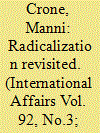|
|
|
Sort Order |
|
|
|
Items / Page
|
|
|
|
|
|
|
| Srl | Item |
| 1 |
ID:
109783


|
|
|
|
|
| Publication |
2011.
|
| Summary/Abstract |
The London bombings in 2005 led to the perception that the terrorist threat had changed from external to internal. This became conceptualized shortly after as "homegrown terrorism." This article deals with the meaning and scope of this phenomenon. We begin by tracing an ambiguity in the term "homegrown," which is both about belonging in the West and autonomy from terrorist groups abroad. A quantitative study of Islamist terrorism in the West since 1989 reveals an increase in both internal and autonomous terrorism since 2003 and that most plots are now internal-but not autonomous. Finally we suggest that an increase in autonomous terrorism is a transitory phenomenon.
|
|
|
|
|
|
|
|
|
|
|
|
|
|
|
|
| 2 |
ID:
172547


|
|
|
|
|
| Summary/Abstract |
Islamic State videos have often been associated with savage violence and beheadings. An in-depth scrutiny however reveals another striking feature: that female bodies are absent, blurred or mute. Examining a few Islamic State videos in depth, the article suggests that the invisibility of women in tandem with the ostentatious visibility of male bodies enable gendered and embodied spectators to indulge in homoerotic as well as heterosexual imaginaries. In contrast to studies on visual security and online radicalization which assert that images affect an audience, this article focuses on the interaction between video and audience and argues that spectators are not only rational and emotional but embodied and gendered as well. Islamic State videos do not only attract western foreign fighters through religious–ideological rhetoric or emotional impact but also through gendered forms of pleasure and desire that enable carnal imagination and identification. The article probes the analytical purchase of carnal aesthetics and spectatorship.
|
|
|
|
|
|
|
|
|
|
|
|
|
|
|
|
| 3 |
ID:
145287


|
|
|
|
|
| Summary/Abstract |
For more than a decade, ‘radicalization’ has been a keyword in our understanding of terrorism. From the outset, radicalization was conceived of as an intellectual process through which an individual would increasingly come under a spell of extremist ideas. This ideological understanding of radicalization still prevails. In a 2015 speech on extremism, British Prime Minister David Cameron, for instance, claimed that the ‘root cause of the threat we face is the extremist ideology itself’. But the way we understand radicalization has specific consequences for the way we manage and fight the scourge of terrorism. Considering recent events, including the November 2015 Paris attacks, the present article sets out to reassess the above-mentioned intellectualist understanding of radicalization and come up with new suggestions as to how radicalization may be understood today. Initially, the article suggests that ideology is not necessarily a precondition for violence, but that a prior experience with violence is more often a precondition for engaging an extremist ideology. Such experience with violence can be both domestic and international, obtained in Europe or Syria and other conflict zones. In the second part of the article it is argued that although radicalization is often conceived of as an individual process, pathways towards terrorism are inherently social and political. Finally, the article argues that by stressing the importance of ideology and ideological processes, concepts of radicalization have abstracted away from another factor that is pivotal for understanding pathways towards terrorist violence: the skills and capacities of the body.
|
|
|
|
|
|
|
|
|
|
|
|
|
|
|
|
| 4 |
ID:
134734


|
|
|
|
|
| Summary/Abstract |
One of the ways in which the relationship between religion and violence has been conceptualized is through the concept of “radicalization”. In the wake of the London bombings, “radicalization” became a favored policy term that was reinvented in order to manage and prevent the new phenomenon of “homegrown terrorism”. Around 2005, it was a widespread assumption that “homegrown terrorism” had a religious dimension, and the concept of “radicalization” therefore had to articulate how religion and terrorism were related. Most concepts of radicalization describe a cognitive transformation, where the progressive adoption of radical religious ideology is the first step in a process that—eventually—could lead to terrorism.
The argument that religion and violence are connected through intellectual processes can also be found in academic literature. Max Weber, who studied the relation between religion and practice, famously argued that a specific Weltanschauung—a protestant ethics—was paving the way for an ascetic practice that contributed to the growth of capitalism.1 More precisely, it was a specific interpretation or rationalization of religious dogma (the idea of predestination) that subsequently made religious actors act in specific ways. Weber’s influence on the study of religion before and after 9/11 cannot be overestimated. Recently, Cecelia Lynch has proposed a neo-Weberian model of how to understand the relationship between religion and violence. “(W)e must first assess”, she writes, “what religious guidelines suggest for particular situations, and then look more deeply into how religious actors interpret those guidelines – how they bridge the gap between religious rules and particular situations to decide how to act”.2 In the same vein, Juergensmeyer & Sheikh have argued that the key to understanding the religion/violence-nexus is to scrutinize the “epistemic worldviews” of violent actors. According to this “socio-theological” approach, the important question is not why the violent actors did what they did,
|
|
|
|
|
|
|
|
|
|
|
|
|
|
|
|
|
|
|
|
|